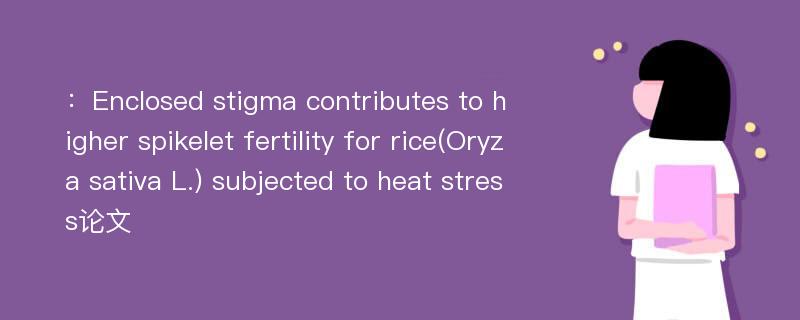
本文主要研究内容
作者(2019)在《Enclosed stigma contributes to higher spikelet fertility for rice(Oryza sativa L.) subjected to heat stress》一文中研究指出:With global warming, rice plants may be subjected to heat stress more regularly during the heatsensitive flowering stage, causing spikelet sterility and grain yield loss.Stigma exsertion is considered to increase pollen reception and promote female reproductive success.The aim of this study was to investigate the role of stigma exsertion on spikelet fertility at high temperatures.Five rice cultivars(Liangyoupeijiu, Shanyou 63, Huanghuazhan, Nagina 22, and IR64) with differing degrees of stigma exsertion were cultivated and exposed to high temperature at anthesis.Heat-tolerant cultivars did not always show a high percentage of spikelets with exserted stigmas, and vice versa.Irrespective of the presence of more pollen grains on exserted stigmas, spikelets with exserted stigmas did not show greater spikelet fertility than spikelets with fewer exserted stigmas or hidden stigmas under heat stress.GA3 application augmented the percentage of spikelets with exserted stigmas; however, it did not increase spikelet fertility under heat stress.Spikelet fertility of whole panicles was negatively correlated with the percentage of spikelets with exserted stigmas, but positively with that with hidden stigmas.Viability of the hidden stigmas was less reduced than that of exserted stigmas under heat stress, suggesting that hidden stigmas have an advantage in maintaining viability.Heat stress delayed anther dehiscence and reduced the viabilities of both exserted stigmas and pollens, thereby causing low spikelet fertility.Together, these results suggest that high spikelet fertility does not depend on stigma exsertion and that enclosed stigma generally contributes to higher spikelet fertility and heat tolerance under high-temperature conditions during flowering in rice.
Abstract
With global warming, rice plants may be subjected to heat stress more regularly during the heatsensitive flowering stage, causing spikelet sterility and grain yield loss.Stigma exsertion is considered to increase pollen reception and promote female reproductive success.The aim of this study was to investigate the role of stigma exsertion on spikelet fertility at high temperatures.Five rice cultivars(Liangyoupeijiu, Shanyou 63, Huanghuazhan, Nagina 22, and IR64) with differing degrees of stigma exsertion were cultivated and exposed to high temperature at anthesis.Heat-tolerant cultivars did not always show a high percentage of spikelets with exserted stigmas, and vice versa.Irrespective of the presence of more pollen grains on exserted stigmas, spikelets with exserted stigmas did not show greater spikelet fertility than spikelets with fewer exserted stigmas or hidden stigmas under heat stress.GA3 application augmented the percentage of spikelets with exserted stigmas; however, it did not increase spikelet fertility under heat stress.Spikelet fertility of whole panicles was negatively correlated with the percentage of spikelets with exserted stigmas, but positively with that with hidden stigmas.Viability of the hidden stigmas was less reduced than that of exserted stigmas under heat stress, suggesting that hidden stigmas have an advantage in maintaining viability.Heat stress delayed anther dehiscence and reduced the viabilities of both exserted stigmas and pollens, thereby causing low spikelet fertility.Together, these results suggest that high spikelet fertility does not depend on stigma exsertion and that enclosed stigma generally contributes to higher spikelet fertility and heat tolerance under high-temperature conditions during flowering in rice.
论文参考文献
论文详细介绍
论文作者分别是来自The Crop Journal的,发表于刊物The Crop Journal2019年03期论文,是一篇关于,The Crop Journal2019年03期论文的文章。本文可供学术参考使用,各位学者可以免费参考阅读下载,文章观点不代表本站观点,资料来自The Crop Journal2019年03期论文网站,若本站收录的文献无意侵犯了您的著作版权,请联系我们删除。
